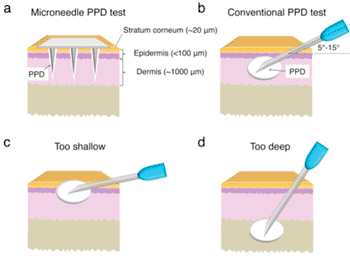Biodegradable Microneedle Patch Automates Tuberculosis Skin Testing
|
By LabMedica International staff writers Posted on 04 Sep 2013 |

Image: A chitin microneedle patch tested on human skin (Photo courtesy of the University of Washington).

Image: Comparison of a microneedle tuberculosis test with a traditional test administered with a hypodermic needle. The lower images show needle-depth problems that can occur with the conventional test (Photo courtesy of the University of Washington).
A patch comprising biodegradable microneedles has been developed that may replace the classical hypodermic needle tuberculin diagnostic test for tuberculosis.
The standard diagnostic test for tuberculosis (termed the Mantoux technique) is based on an intradermal injection of tuberculin, which is a species-nonspecific glycerol extract of the tubercle bacillus obtained from filtrates of sterilized, concentrated cultures. A person who has been exposed to tuberculosis bacteria is expected to mount an immune response in the skin containing the bacterial proteins. The reaction is read by measuring the diameter of induration (palpable raised, hardened area) across the forearm (perpendicular to the long axis) in millimeters.
However, the standard diagnostic test is difficult to perform, since obtaining a correct diagnosis depends on the hypodermic needle being inserted into the arm of the patient at a precise angle and depth.
Investigators at the University of Washington (Seattle, USA) recently reported development of a technique that promises to be a significant improvement to the Mantoux technique. They created a patch containing biodegradable chitin microneedles. Each needle is 750 micrometers long and is coated with tuberculin solution.
The patch test was evaluated on guinea pigs, and results showed that following insertion of the microneedles, the positive skin reaction associated with having a tuberculosis infection was identical to that obtained when using the standard hypodermic needle test.
"It is like putting on a bandage," said senior author Dr. Marco Rolandi, assistant professor of materials science and engineering at the University of Washington. "As long as the patch is applied on the skin, the test is always delivered to the same depth underneath the skin. With a microneedle test there is little room for user error, because the depth of delivery is determined by the microneedle length rather than the needle-insertion angle. This test is painless and easier to administer than the traditional skin test with a hypodermic needle."
The guinea pig study was published in the August 26, 2013, online edition of the journal Advanced Healthcare Materials.
Related Links:
University of Washington
The standard diagnostic test for tuberculosis (termed the Mantoux technique) is based on an intradermal injection of tuberculin, which is a species-nonspecific glycerol extract of the tubercle bacillus obtained from filtrates of sterilized, concentrated cultures. A person who has been exposed to tuberculosis bacteria is expected to mount an immune response in the skin containing the bacterial proteins. The reaction is read by measuring the diameter of induration (palpable raised, hardened area) across the forearm (perpendicular to the long axis) in millimeters.
However, the standard diagnostic test is difficult to perform, since obtaining a correct diagnosis depends on the hypodermic needle being inserted into the arm of the patient at a precise angle and depth.
Investigators at the University of Washington (Seattle, USA) recently reported development of a technique that promises to be a significant improvement to the Mantoux technique. They created a patch containing biodegradable chitin microneedles. Each needle is 750 micrometers long and is coated with tuberculin solution.
The patch test was evaluated on guinea pigs, and results showed that following insertion of the microneedles, the positive skin reaction associated with having a tuberculosis infection was identical to that obtained when using the standard hypodermic needle test.
"It is like putting on a bandage," said senior author Dr. Marco Rolandi, assistant professor of materials science and engineering at the University of Washington. "As long as the patch is applied on the skin, the test is always delivered to the same depth underneath the skin. With a microneedle test there is little room for user error, because the depth of delivery is determined by the microneedle length rather than the needle-insertion angle. This test is painless and easier to administer than the traditional skin test with a hypodermic needle."
The guinea pig study was published in the August 26, 2013, online edition of the journal Advanced Healthcare Materials.
Related Links:
University of Washington
Latest Microbiology News
- New Blood Test Detects Up to Five Infectious Diseases at POC
- Molecular Stool Test Shows Potential for Diagnosing TB in Adults with HIV
- New Test Diagnoses Bacterial Meningitis Quickly and Accurately
- Handheld Device Delivers Low-Cost TB Results in Less Than One Hour
- New AI-Based Method Improves Diagnosis of Drug-Resistant Infections
- Breakthrough Diagnostic Technology Identifies Bacterial Infections with Almost 100% Accuracy within Three Hours
- Innovative ID/AST System to Help Diagnose Infectious Diseases and Combat AMR
- Gastrointestinal Panel Delivers Rapid Detection of Five Common Bacterial Pathogens for Outpatient Use
- Rapid PCR Testing in ICU Improves Antibiotic Stewardship
- Unique Genetic Signature Predicts Drug Resistance in Bacteria
- Unique Barcoding System Tracks Pneumonia-Causing Bacteria as They Infect Blood Stream
- Rapid Sepsis Diagnostic Test Demonstrates Improved Patient Care and Cost Savings in Hospital Application
- Rapid Diagnostic System to Detect Neonatal Sepsis Within Hours
- Novel Test to Diagnose Bacterial Pneumonia Directly from Whole Blood
- Interferon-γ Release Assay Effective in Patients with COPD Complicated with Pulmonary Tuberculosis
- New Point of Care Tests to Help Reduce Overuse of Antibiotics
Channels
Clinical Chemistry
view channel
AI-Powered Blood Test Accurately Detects Ovarian Cancer
Ovarian cancer ranks as the fifth leading cause of cancer-related deaths in women, largely due to late-stage diagnoses. Although over 90% of women exhibit symptoms in Stage I, only 20% are diagnosed in... Read more
Automated Decentralized cfDNA NGS Assay Identifies Alterations in Advanced Solid Tumors
Current circulating cell-free DNA (cfDNA) assays are typically centralized, requiring specialized handling and transportation of samples. Introducing a flexible, decentralized sequencing system at the... Read more
Mass Spectrometry Detects Bacteria Without Time-Consuming Isolation and Multiplication
Speed and accuracy are essential when diagnosing diseases. Traditionally, diagnosing bacterial infections involves the labor-intensive process of isolating pathogens and cultivating bacterial cultures,... Read more
First Comprehensive Syphilis Test to Definitively Diagnose Active Infection In 10 Minutes
In the United States, syphilis cases have surged by nearly 80% from 2018 to 2023, with 209,253 cases recorded in the most recent year of data. Syphilis, which can be transmitted sexually or from mother... Read moreMolecular Diagnostics
view channel
Microbial Cell-Free DNA Test Accurately Identifies Pathogens Causing Pneumonia and Other Lung Infections
Bronchoalveolar lavage (BAL) is a commonly used procedure for diagnosing lung infections, especially in immunocompromised patients. However, standard tests often fail to pinpoint the exact pathogen, leading... Read more
Non-Biopsy Approach to Transform Adult Celiac Disease Diagnoses
In the United States, the diagnosis of celiac disease in adults typically relies on a combination of serologic testing and a confirmatory small bowel biopsy during upper endoscopy. In contrast, European... Read moreHematology
view channel
First Point-of-Care Heparin Monitoring Test Provides Results in Under 15 Minutes
Heparin dosing requires careful management to avoid both bleeding and clotting complications. In high-risk situations like extracorporeal membrane oxygenation (ECMO), mortality rates can reach about 50%,... Read more
New Scoring System Predicts Risk of Developing Cancer from Common Blood Disorder
Clonal cytopenia of undetermined significance (CCUS) is a blood disorder commonly found in older adults, characterized by mutations in blood cells and a low blood count, but without any obvious cause or... Read moreImmunology
view channel
Stem Cell Test Predicts Treatment Outcome for Patients with Platinum-Resistant Ovarian Cancer
Epithelial ovarian cancer frequently responds to chemotherapy initially, but eventually, the tumor develops resistance to the therapy, leading to regrowth. This resistance is partially due to the activation... Read more
Machine Learning-Enabled Blood Test Predicts Immunotherapy Response in Lymphoma Patients
Chimeric antigen receptor (CAR) T-cell therapy has emerged as one of the most promising recent developments in the treatment of blood cancers. However, over half of non-Hodgkin lymphoma (NHL) patients... Read morePathology
view channel
Groundbreaking Chest Pain Triage Algorithm to Transform Cardiac Care
Cardiovascular disease is responsible for a third of all deaths worldwide, and chest pain is the second most common reason for emergency department (ED) visits. With EDs often being some of the busiest... Read more
AI-Based Liquid Biopsy Approach to Revolutionize Brain Cancer Detection
Detecting brain cancers remains extremely challenging, with many patients only receiving a diagnosis at later stages after symptoms like headaches, seizures, or cognitive issues appear. Late-stage diagnoses... Read moreTechnology
view channel
Advanced Predictive Algorithms Identify Patients Having Undiagnosed Cancer
Two newly developed advanced predictive algorithms leverage a person’s health conditions and basic blood test results to accurately predict the likelihood of having an undiagnosed cancer, including ch... Read more
Light Signature Algorithm to Enable Faster and More Precise Medical Diagnoses
Every material or molecule interacts with light in a unique way, creating a distinct pattern, much like a fingerprint. Optical spectroscopy, which involves shining a laser on a material and observing how... Read more
Disposable Microchip Technology Could Selectively Detect HIV in Whole Blood Samples
As of the end of 2023, approximately 40 million people globally were living with HIV, and around 630,000 individuals died from AIDS-related illnesses that same year. Despite a substantial decline in deaths... Read more
Pain-On-A-Chip Microfluidic Device Determines Types of Chronic Pain from Blood Samples
Chronic pain is a widespread condition that remains difficult to manage, and existing clinical methods for its treatment rely largely on self-reporting, which can be subjective and especially problematic... Read moreIndustry
view channel
Cepheid and Oxford Nanopore Technologies Partner on Advancing Automated Sequencing-Based Solutions
Cepheid (Sunnyvale, CA, USA), a leading molecular diagnostics company, and Oxford Nanopore Technologies (Oxford, UK), the company behind a new generation of sequencing-based molecular analysis technologies,... Read more
Grifols and Tecan’s IBL Collaborate on Advanced Biomarker Panels
Grifols (Barcelona, Spain), one of the world’s leading producers of plasma-derived medicines and innovative diagnostic solutions, is expanding its offer in clinical diagnostics through a strategic partnership... Read more



















